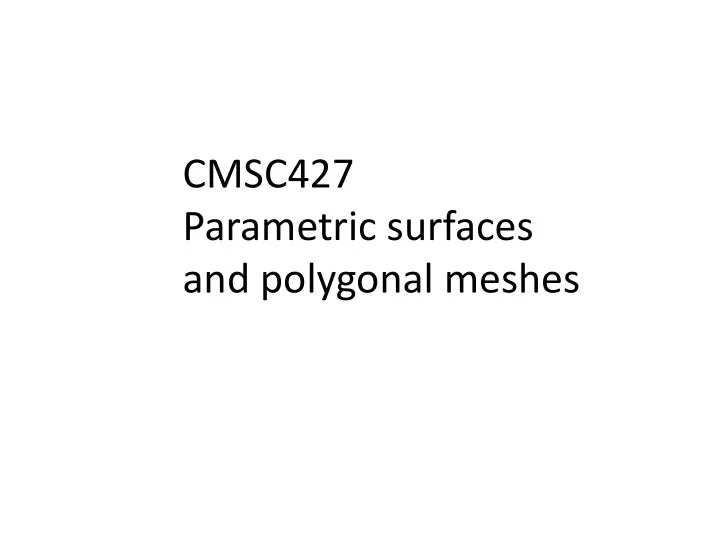

CMSC427 Parametric surfaces and polygonal meshes
Note • These slides are incomplete • See accompanying PDF with detailed outline • Will develop many equations in class • Reading later to supplement
Moving to 3D • Polygonal meshes • Set of standard shapes in Blender • And how to create them • And store them • And draw them
Bilinear patch • Blending of four 3D points • Ruled surface • Swept out by sequence of lines P1 P2 P0 P3
Bilinear patch • Blend simultaneously along two lines • P01 = t(P1-P0) + P0 • P23 = t(P2-P3) + P3 P1 P2 • Same t in [0,1] P01 P23 P0 P3
Bilinear patch • Blend simultaneously along two lines P1 P2 • P01 = tP1 + (1-t)P0 • P23 = tP3 + (1-t)P2 P01 P P23 • Same t in [0,1] P0 • Then blend between the two lines P3 • P = sP23 + (1-s)P01 • P = s(tP1 + (1-t)P0) + (1-s)(tP3 + (1-t)P2)
Bilinear patch • Questions • What order polynomial? P1 P2 • Convex combination? • What is drawn if t is constant? P01 P P23 • What is drawn if s is constant? P0 P3 • P = s(tP1 + (1-t)P0) + (1-s)(tP3 + (1-t)P2)
Bilinear patch • Questions • What order polynomial? P1 P2 • Convex combination? • What is drawn if t is constant? P01 P P23 • What is drawn if s is constant? P0 P3 • P = s(tP1 + (1-t)P0) + (1-s)(tP3 + (1-t)P2) • P = stP1 + s(1-t)P0 + (1-s)tP3 + (1-s)(1-t)P2
Coons patch • What’s happening in this surface?
Coons patch • What’s happening in this surface? • Blending two arcs • Is this a ruled surface?
Coons patch • Blend four arbitrary curves • Here C1, C2, D1, D2
Circle with trig: review Parametric equation 𝑦 = 𝑆 cos (𝑢) sin (𝑢) t 𝑧 = 𝑆 sin (𝑢) cos (𝑢) 0 ≤ 𝑢 ≤ ? ?
Parametric cone h r
Parametric cylinder h r
Rendering faces: need location and normal • Need distance and orientation relative to lights to compute reflected light
Polygonal mesh • Simplest mesh: tetrahedron • Indexed mesh representation • Vertex list • Normal list • Face list • Non-indexed representation • List of faces with repeated vertices
Polygonal mesh • Hill’s barn • 10 vertices • 7 faces • 7 normals
Polygonal mesh • Hill’s barn • 10 vertices • 7 faces • 7 normals • Solution for one face: • Face vertices (CCW): • 5 6 7 8 9 • Face normals: • 5 5 5 5 5 • Alternative: triangulate • Face1: 5 6 7, Face2: 5 7 9, Face 3: 7 8 9
Drawing mesh • Draw as points: iterate through points • Draw as lines: iterate through adj. pts. in faces • Problem? • Alternative: add edge list to structure • Alternative: better link faces to avoid redundancy • Draw as ”solid”: iterate through faces
File formats • STL • https://en.wikipedia.org/wiki/STL_(file_format) • OBJ • https://en.wikipedia.org/wiki/Wavefront_.obj_file • Many others • Not hard to generate your own STL files
Meshlab • Free viewing software: Meshlab • (http://www.meshlab.net) • Good for viewing, repairing, decimating meshes • Sources of 3D mesh models: • SketchFab (https://sketchfab.com) • Thingiverse (https://www.thingiverse.com) • Stanford repository (http://graphics.stanford.edu/data/3Dscanrep/) • Std Examples: Utah teapot, Stanford bunny
Generating polygonal mesh from parametric surface • Step 1: • Sources of 3D mesh models: • SketchFab (https://sketchfab.com) • Thingiverse (https://www.thingiverse.com) • Stanford repository (http://graphics.stanford.edu/data/3Dscanrep/) • Std Examples: Utah teapot, Stanford bunny
T opological properties of meshes • Is a mesh well connected? • Any flaws? • More later
Generating mesh from parametric surface • Given parametric surface • P(u,v) = < x(u,v), y(u,v), z(u,v) > • Generate mesh • Steps: i= 0 1 2 3 4 • 1. Set # divisions in u= u0 j= v= u1 u2 u3 u4 0 v0 u,v as n, m • 2. Generate u,v 1 v1 in for loops V0 V3 V=<x,y,z> face • 3. Store in 2D array of 3D points 2 v2 V1 V2 • 4. From array generate faces 3 v3 4 v4
Computing normal vectors for mesh • Approach 1: Cross product of numeric data • Find v1 and v2 from vertices (which?) • N = v1 x v2 • Less arbitrary: Newell’s method • Approach 2: Partial derivatives of parametric curve • Given vector P(u,v) = < x(u,v), y(u,v), z(u,v)> • Derive vectors dU = dP(u,v)/du and dV = dP(u,v)/dv • N = dU x dV • Approach 3: Gradient vector of implicit surface • Given implicit function f(x,y,z) • Derive gradient < df/dx, df/dy, df/dz >
Creating polygonal meshes: summary • Fixed shapes. • Any shape based on idiosyncratic data, such as the exact shape of a stone, foot, sculpture, etc. All hard-coded, some from real world data collection • Regular polyhedron • Cubes, tetrahedrons, icosahedrons, dodecahedrons, ... • Operations that create shapes • Extrusion • Lathing (surfaces of rotation) • Surface subdivision • Parametric shapes (related to operations) • Bilinear patches, quadrics, superellipses, etc.
Recommend
More recommend